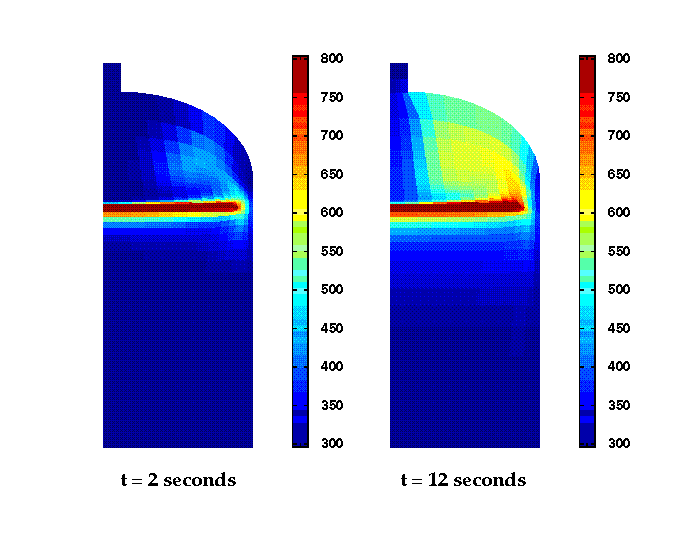Rapid Thermal Processing
One particular area of great current research interest is Rapid Thermal
Processing (RTP), which is a versatile, single-wafer approach to
semiconductor wafer processing that is suitable for several applications
including annealing, cleaning, chemical vapor deposition, oxidation,
and nitridation. RTP provides a rich variety of problems in modeling,
simulation, and control. Here we provide a brief introduction to our
work in this area during 1995 and 1996.
RTP System Gas Phase Simulation and Model Reduction
A. J. Newman; Advisors: R. A. Adomaitis and P. S. Krishnaprasad
Computer Aided Control Systems Engineering Lab and
Intelligent Servosystems Lab
Project Background and Goals
Rapid Thermal Processing (RTP) is a versatile, cold-wall, single-wafer
approach to semiconductor wafer processing suitable for several applications
including annealing, cleaning, chemical vapor deposition (RTCVD), oxidation,
and nitridation. RTCVD systems offer several advantages over conventional
CVD systems including improved wafer-to-wafer deposition uniformity and
reduced thermal budgets. The main obstacles for full acceptance of RTCVD into
manufacturing are temperature reproducibility and uniformity during the
thermal cycle when thin films are being deposited on the wafer surface.
Our research focuses on the NC State Three Zone RTP System. For this system,
the gas phase transport of energy and reactant species is examined in order
to determine those factors which contribute substantially to deposition
nonuniformity. Ultimately, the goal is to develop low order models for use
in real-time simulation and model-based sensing and control. In particular,
reduced-order gas phase models may be useful for determining the wafer state
from available measurements of the tool state.
Methodology/Procedure
Reactor system geometry and operating conditions are based on the 3 zone
furnace at NC State University. Modeling and high-fidelity simulation of
the fluid phase transport of momentum and enthalpy are carried out with the
Fluent computational fluid dynamics (CFD) software package. During the initial
transient, "snapshots" of the fluid flow and temperature fields are captured.
These snapshots have a certain degree of correlation due to the evolution of
the flow fields being described by well defined equations of motion. These
coherent structures are extracted via the Proper Orthogonal Decomposition,
giving an empirically determined set of basis functions.
Project Results
An RTP simulator describing the gas phase flow and thermal dynamics
has been developed. We have shown that the details of the flow and
temperature fields can be captured with a time-varying linear combination
of relatively few empirically determined spatial modes. In addition,
initial estimates of heat transfer from the wafer to the gas phase indicate
that this heat transfer is not a significant factor in causing nonuniformities.
Significance
Decomposing the spatial structure of the gas phase dynamics into its
underlying coherent structures results in a set of trial functions which
can be used as a basis in a Galerkin discretization of the original
equations of fluid motion. This results in an extremely low order
ODE model, suitable for real-time simulation. Furthermore, understanding
the nonlinear, dynamic coupling between the modes is crucial to
understanding the relationship between the manipulated variables and
the spatial variations to be controlled, and to combining sensor measurements
in order to estimate the wafer state.
Future Directions
Transport of reacting and deposition product species for depletion
studies and residual gas analysis sensor development is currently
being pursued. With this complete model of gas phase transport, we intend
to explore the relationship between coherent structures, sensor placement,
and how one might specify the minimum number of gas phase/tool state sensors
required to uniquely determine the wafer state.
The NC State University Three Lamp Zone RTCVD System
![[NCSU RTP System]](ncsu_rtp_system.gif)
Temperature Field Snapshots

Optimal Eigenmodes of the System

Page maintained by Andrew Newman. Send comments to
![[Mail Icon]](http://www.isr.umd.edu/images_shared/mailbox.gif) newman@isr.umd.edu
Latest Update: December 30, 1997.
newman@isr.umd.edu
Latest Update: December 30, 1997.
![[NCSU RTP System]](ncsu_rtp_system.gif)


![[Mail Icon]](http://www.isr.umd.edu/images_shared/mailbox.gif) newman@isr.umd.edu
Latest Update: December 30, 1997.
newman@isr.umd.edu
Latest Update: December 30, 1997.